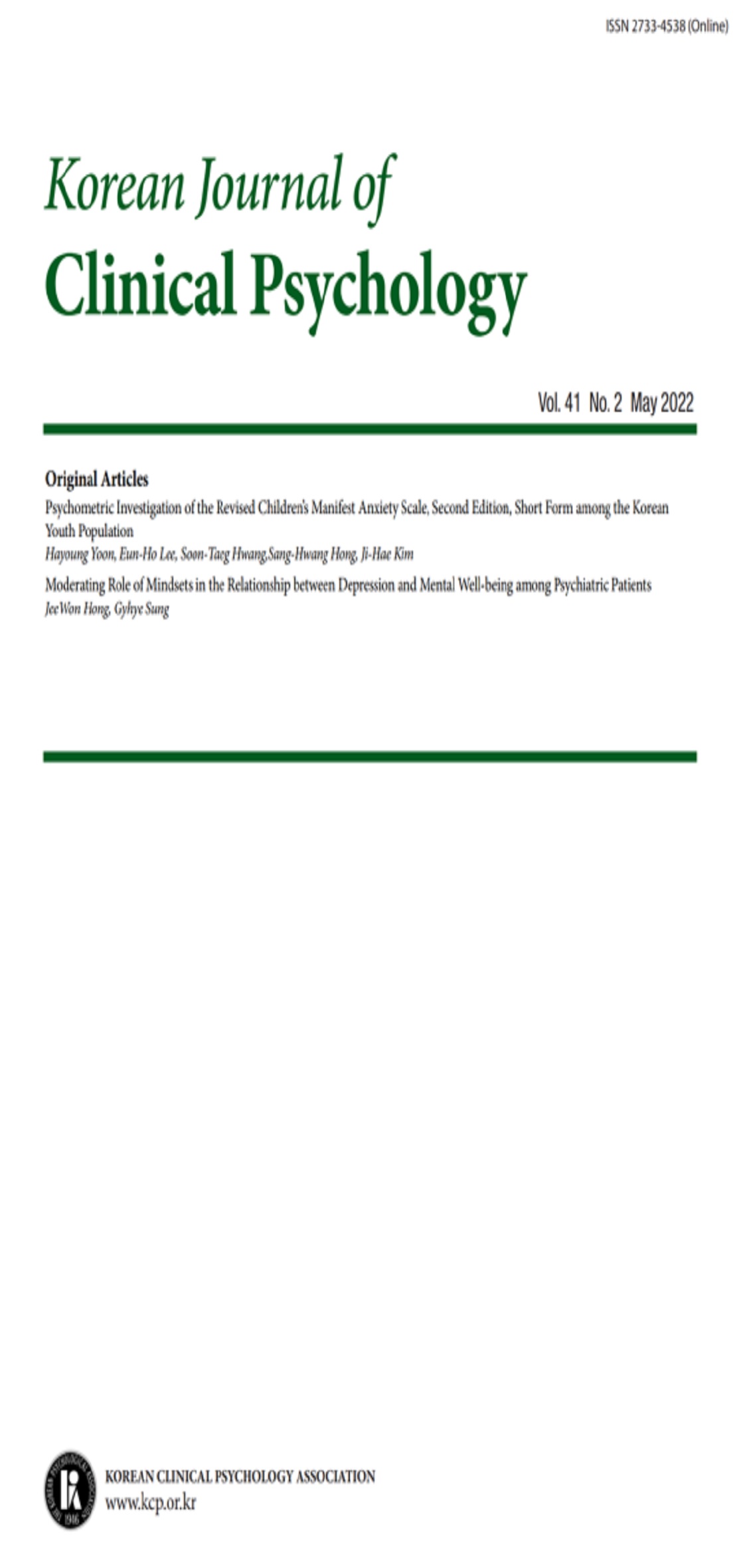open access
메뉴
open access
메뉴 E-ISSN : 2733-4538
E-ISSN : 2733-4538
본 연구는 개인의 정서조절방략을 평가하는 자기보고형 질문지를 개발하기 위한 것이다. 다양한 정서조절방략을 인지적․체험적․행동적 방략으로 구분하고 이를 측정하는 질문지를 제작하여 그 신뢰도와 타당도를 확인하였다. 488명의 대학생 자료에 근거하여 개발한 69문항의 정서조절방략 질문지(ERSQ)는 인지적 방략 5개, 체험적 방략 5개, 행동적 방략 6개를 측정하고 있다. 426명의 대학생을 대상으로 조사된 신뢰도와 타당도 역시 적절한 것으로 확인되었다. 끝으로 본 연구에 대한 시사점과 제한점, 그리고 추후 연구에 대해 논의하였다.
The purpose of this study is to develop a self-report questionnaire measuring emotion regulation strategies. The questionnaire was designed to assess emotion regulation strategies in terms of cognitive, experiential and behavioral strategies, and its reliability and validity were examined. The Emotion Regulation Strategy Questionnaire with 69 items was constructed using factor analyses on the data of 488 undergraduates on preliminary items. The ERSQ was found to measure sixteen strategies for emotion regulation: five cognitive, five experiential and six behavioral strategies. Reliability and validity of the ERSQ was supported by the results obtained from 426 undergraduates. Finally, the implications and the limitations of the study and suggestions for future research were discussed.
(2000) 부정적 정서 조절 방략에 관한 연구: 정서 종류와 개인 변인에 따른 정서조절 양식의 차이.,
(1995) 한국형 자가평가 우울척도의 개발,
(2006) 정서조절과 정신병리의 관계: 연구 현황과 과제,
(1998) 한국판 상태-특성 분노 표현 척도(STAXI-K),
(2000) 구조방정식의 모형의 적합도 지수 선정기준과 그 근거,
(1988) . An inventory for measuring clinical anxiety Psychometric properties. Journal of Consulting and Clinical Psychology,
(2006) Effects of suppression and acceptance on emotional responses of individuals with anxiety and mood disorders.,
(1989) A theoretically based approach. Journal of Personality and Social Psychology,
(1994) . The development of emotion regulation and dysregulation A clinical perspective. In N. A. Fox The development of emotion regulation. Biological and behavioral considerations . Monographs of the Society for Research in Child Development,
(2000) The transforming power of affect, New York: Basic Books
(1991) . The development of emotion regulation and dysregulation. New York, Cambridge University Press.
(2001) Negative life events, cognitive emotion regulation and emotional problems.,
(2002) Emotion-focused therapy. Coaching clients to work through their feelings,
(1999) Emotion regulation: past, present, future,
(2003) Individual difference in two emotion regulation processes: Implications for affect, relationships, and well-being,
(1999) Mood and forbidden foods' influence on perceptions of binge eating.,
(1997) Affective instability and impulsivity in personality disorder,
(2004) Emotion regulation and psychopathology. In P. Philippot, & R. S. Feldman(Ed.).,
(1992) . Differential roles of dysfunctional attitudes and automatic thoughts in depression A integrated cognitive model of depression. Ph. D. Dissertation submitted to the University of Queensland,
(2005) Dialectical Behavior Therapy in Private Practice,
(1999) Classifying affect-regulation strategies,
(2006) The role of emotional functioning in military-related PTSD and its treatment,
(2005) Thought suppression mediates the relationship between negative affect and borderline personality disorder symptoms,
(2003) Adolescent's emotion regulation in daily life: Links to depressive symptoms and problem behavior.,
(2002) Emotion regulation and understanding implications for child psychopathology and therapy,
(2003) Schema therapy: A practitioner's guide, New York: The Guilford Press.
(1965) . A self-rating depression scale. Archives of General Psychiatry,
